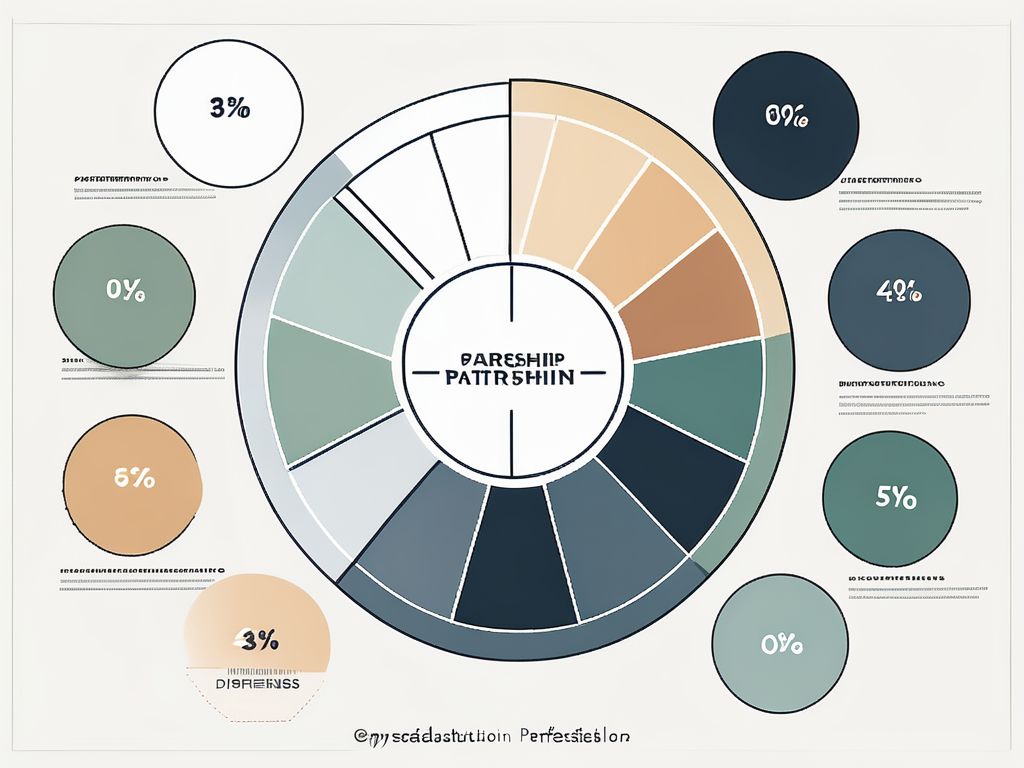Determining partnership percentages is an important step in forming a business partnership. It helps establish each partner’s ownership share and provides a clear understanding of their rights, responsibilities, and financial liabilities. In this article, we will explore the concept of partnership percentage, discuss its significance in business, delve into the key factors to consider, examine the legal aspects related to it, and provide recommendations for managing changes in partnership percentages.
Understanding the Concept of Partnership Percentage
Partnership percentage refers to the proportional ownership interest of each partner in a business. It determines how profits and losses are distributed, as well as how important decisions are made. This percentage is typically based on each partner’s capital contribution, experience, and other relevant factors.

The Importance of Partnership Percentage in Business
The partnership percentage plays a crucial role in ensuring fairness and equality among partners. It establishes a clear framework for decision-making, profit-sharing, and distribution of responsibilities. When partnership percentages are well-defined, it reduces the chances of disputes and fosters a healthy working relationship among partners.
Key Factors to Consider in Partnership Percentage
Several factors need to be considered when determining partnership percentages:
- Capital Contributions: The amount of capital each partner contributes to the business should be a significant factor in determining their partnership percentage. Higher contributions often result in a higher ownership share.
- Experience: Partners who bring valuable skills and industry experience to the table should be appropriately recognized in their partnership percentage.
- Time and Effort: The level of commitment and effort put in by each partner towards the success of the business should be taken into account during the allocation of partnership percentages.
- Future Contributions: Partners who have the potential to bring in valuable contacts, resources, or future opportunities should be considered when determining partnership percentages.
Another important factor to consider in partnership percentages is the level of risk taken by each partner. Partners who are willing to take on higher risks and invest in ventures with potentially higher returns should be rewarded with a larger partnership percentage. This incentivizes partners to make bold decisions and take calculated risks that can lead to the growth and success of the business.
Furthermore, the duration of the partnership should also be taken into account. Partners who have been with the business for a longer period of time have likely contributed significantly to its growth and stability. Recognizing their loyalty and commitment by adjusting their partnership percentage accordingly can help maintain a sense of fairness and motivate long-term dedication.
It is worth noting that partnership percentages are not set in stone and can be adjusted over time. As the business evolves and partners’ contributions change, it may be necessary to revisit and reassess the partnership percentages to ensure they accurately reflect the current dynamics and value each partner brings to the table.
Steps to Determine Partnership Percentage
Follow these steps to determine partnership percentages:
Identifying Each Partner’s Contributions
Start by assessing the contributions of each partner, such as capital invested, assets brought into the business, and any special skills or experience. Assign weightages to these contributions based on their significance to the success of the partnership.
It is crucial to delve deep into the nature of each partner’s contributions. For instance, while financial investments are tangible and easily quantifiable, the value of intellectual property or industry connections brought in by a partner may be more nuanced. Understanding the full spectrum of contributions will ensure a fair and comprehensive assessment.
Evaluating Each Partner’s Role and Responsibilities
Consider the role and responsibilities of each partner within the business. This includes factors such as management duties, decision-making authority, and day-to-day operations. Assign weightages to these responsibilities to reflect each partner’s level of involvement in the partnership.
Furthermore, evaluating the intangible aspects of a partner’s role is equally important. Factors like leadership qualities, strategic vision, and networking abilities can significantly impact the partnership’s success. By acknowledging and incorporating these qualities into the evaluation process, a more holistic view of each partner’s contribution can be achieved.
Legal Aspects of Partnership Percentage
Partnership agreements play a vital role in determining partnership percentages and safeguarding the interests of all partners. The agreement should clearly define how ownership shares are calculated, any provisions for adjustment over time, and procedures for resolving disputes related to partnership percentages.
Understanding the legal aspects of partnership percentages is essential for maintaining a harmonious and fair business relationship among partners. It is not just about the numbers on paper but also about the trust and collaboration that underpin the partnership.
Partnership Agreements and Their Role
A well-drafted partnership agreement should outline the criteria for determining partnership percentages, including the factors discussed earlier. It should also address the process for revisiting and adjusting partnership percentages in the future to accommodate changes in the business or partner dynamics.
In addition to defining ownership percentages, a comprehensive partnership agreement should also detail the responsibilities and obligations of each partner. This clarity helps in setting expectations and ensuring that all partners are on the same page regarding their roles within the partnership.
Legal Implications of Unequal Partnership Percentages
It is crucial to consider the legal implications of unequal partnership percentages. Partners with lower ownership shares should be aware of their rights and protections. Transparency and clear communication are essential to avoid misunderstandings or potential legal issues down the line.
Unequal partnership percentages can sometimes lead to power imbalances within the partnership. It is important for partners to address any disparities proactively and establish mechanisms for addressing concerns or grievances that may arise due to these differences.
Managing Changes in Partnership Percentage
Partnership percentages may need to be re-evaluated over time due to various reasons, such as changes in responsibilities, capital infusion, or changes in the business landscape. It is important to have a process in place to handle such changes smoothly and fairly.

When considering changes in partnership percentages, it is essential to take into account not only the financial contributions of each partner but also their level of involvement in the day-to-day operations of the business. Partners who are more actively engaged in running the business may warrant a higher percentage to reflect their dedication and commitment.
Re-evaluating Partnership Percentages Over Time
Regularly assess the partnership percentages to ensure they remain fair and aligned with the contributions and involvement of each partner. Consider conducting periodic reviews or milestones that trigger a reassessment of partnership percentages.
Additionally, it can be beneficial to involve all partners in the discussion surrounding changes in partnership percentages. Open communication and transparency can help build consensus and maintain a positive working relationship among partners.
Handling Disputes Over Partnership Percentages
If disputes arise regarding partnership percentages, it is crucial to resolve them promptly and amicably. Refer to the provisions outlined in the partnership agreement to address and resolve any disagreements. If necessary, seek professional guidance from a lawyer or mediator to facilitate a fair resolution.
It is also advisable to document any changes in partnership percentages formally to avoid misunderstandings in the future. Clearly outline the reasons for the adjustment and ensure that all partners are in agreement before moving forward with the changes.
Conclusion: Ensuring a Fair Partnership Percentage
Determining partnership percentages is a critical step in establishing a successful and harmonious business partnership. It requires careful consideration of various factors, including capital contributions, experience, responsibilities, and future potential. By addressing the legal aspects and establishing transparent communication channels, partners can ensure fairness and longevity in their business venture.

Best Practices for Determining Partnership Percentage
To determine a fair partnership percentage, it is essential to:
- Consider all relevant factors, including capital contributions, experience, and future potential.
- Document the criteria and process for determining partnership percentages in a well-drafted partnership agreement.
- Regularly review and reassess partnership percentages to accommodate changes in the business or partner dynamics.
- Promote transparency and open communication among partners to minimize misunderstandings or disputes.
The Role of Transparency and Communication in Partnership Percentages
Transparency and open communication are foundational to maintaining trust and harmony within a business partnership. Partners should engage in honest and regular dialogue about partnership percentages, ensuring that everyone understands the rationale behind the allocation. This fosters a collaborative environment where partners can work collectively towards the success of the business


